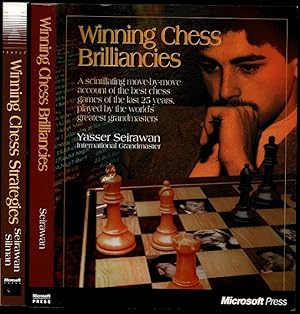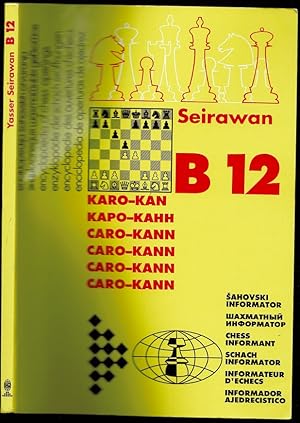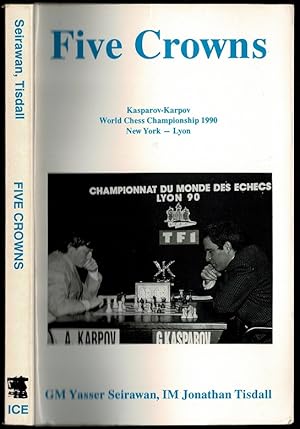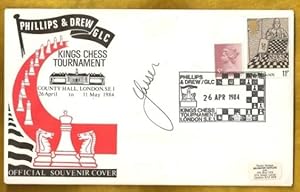Yasser Seirawan 1960 (7 results)
FeedbackSearch filters
Product Type
- All Product Types
- Books (4)
- Magazines & Periodicals (1)
- Comics (No further results match this refinement)
- Sheet Music (No further results match this refinement)
- Art, Prints & Posters (No further results match this refinement)
- Photographs (No further results match this refinement)
- Maps (No further results match this refinement)
- Manuscripts & Paper Collectibles (2)
Condition Learn more
- New (No further results match this refinement)
- As New, Fine or Near Fine (1)
- Very Good or Good (6)
- Fair or Poor (No further results match this refinement)
- As Described (No further results match this refinement)
Binding
- All Bindings
- Hardcover (No further results match this refinement)
- Softcover (5)
Collectible Attributes
- First Edition (7)
- Signed (3)
- Dust Jacket (No further results match this refinement)
- Seller-Supplied Images (7)
- Not Print on Demand (7)
Language (2)
Free Shipping
- Free Shipping to U.S.A. (No further results match this refinement)
Seller Location
Seller Rating
-
Winning Chess Strategies and Brilliancies
Published by Microsoft Press, Redmond, WA, 1994
ISBN 10: 1556159102 ISBN 13: 9781556159107
Language: English
Seller: The Book Collector, Inc. ABAA, ILAB, Fort Worth, TX, U.S.A.
First Edition
Soft cover. Condition: Very Good. 1st Edition. 2 volumes. Winning Chess Strategies: x+257 pages with diagrams, photographs and index. Winning Chess Brilliancies: xii+257 pages with diagrams and index. Royal octavos (9 1/4" x 7 1/4") bound in original publisher's pictorial wrappers. First and second printings. Winning Chess Strategies is to knock your opponent off balance with bold opening moves Formulate an overall game strategy before the middle game Understand the motivation behind your opponents every move Position yourself for a winning endgame. A special section features actual games of history's greatest chess strategists. Winning Chess Brilliancies A move-by-move account of the best chess games of the last 25 years, played by the world's greatest grandmasters. Condition: Some edge wear, occasional rippling to some of back pages else very good set.
-
Caro Kann B12
Published by Chess Informant, Beograd (Belgrade), 1993
Seller: The Book Collector, Inc. ABAA, ILAB, Fort Worth, TX, U.S.A.
First Edition
Soft cover. Condition: Very Good. 1st Edition. 95 pages with diagrams and index. Royal octavo (9 1/4" x 6 1/2") bound in original publisher's pictorial wrappers. First edition. The Caro Kann is a common defence against the King's Pawn Opening and is classified as a "Semi-Open Game" like the Sicilian Defence and French Defence, although it is thought to be more solid and less dynamic than either of those openings. It often leads to good endgames for Black, who has the better pawn structure. Condition: Light edge wear, corners bumped, rubbed and creased else very good.
-
Tilburg Chess tournament 1992 in Inside Chess Volume 5, number 7
Published by International Chess Enterprises, Seattle, 1992
Seller: The Book Collector, Inc. ABAA, ILAB, Fort Worth, TX, U.S.A.
First Edition
Soft cover. Condition: Very Good. 1st Edition. [3]-55 pages with diagrams, photographs and tables. Quarto (10 1/2" x 8 1/4") bound in original publisher's pictorial wrappers. First edition. The Tilburg chess tournament was a series of very strong chess tournaments held in Tilburg, Netherlands. It was established in 1977 and ran continuously through 1994 under the sponsorship of Interpolis, an insurance company. Fontys Hogescholen shortly revived the tournament series from 1996 to 1998, when the last edition was played. Since 1994 there is another annual chess tournament taking place in Tilburg, which has the name De Stukkenjagers, the field is generally much weaker than the traditional Tilburg tournament. In 1992 the tournament was for the first time held in the knockout format and comprised three days per round. Game one on day one, game two on day two (both at classic time limits). Day three was a rest day, but for those tied 1-1 it was the day to play two more tie-break games (each with rapid time limit) and in a few cases, another two. The format was described by some commentators as very brutal. Anyone getting off to a slow start would be eliminated and sent home in just two or three days, such as happened to the entire Hungarian squad of Lajos Portisch, Gyula Sax, Zoltán Ribli, József Pintér and Peter Leko. Those who did not win cleanly in the initial two games of each round found fatigue a great problem, due to having to give up their rest days. The benefit over the old double round-robin format, was that it opened up the potential for an unexpected winner and this made it exciting for the spectators. The traditional format favors those highly graded players who win year after year by agreeing quick draws against their closest rivals and defeating the rest. The 1992 edition had 111 participants, 94 in round one, with the 47 winners then being joined by 17 seeded players given a bye to round two. Round two therefore comprised 64 players, round three 32 and round four 16. At the time, this was the largest prize fund of any traditional tournament. Adams won 100,000 Dutch guilders, the overall fund was 500,000 dg. The seeded players were given very generous conditions of a guaranteed 10,000 guilders to ensure their attendance. The tournament came down to the last two standing Michael Adams and Boris Gelfand with Adams winning 2 1/2 to 1 1/2. Condition: Corners bumped, edge wear, spine heal chipped else a very good copy.
-
Inside Chess: Candidates Issue (Quarter Finals)
Published by International Chess Enterprises, Seattle, 1989
Seller: The Book Collector, Inc. ABAA, ILAB, Fort Worth, TX, U.S.A.
Magazine / Periodical First Edition
Soft cover. Condition: Very Good. 1st Edition. 32 pages with diagrams, photographs and tables. Quarto (10 3/4" x 8 1/4") bound in original publisher's stapled pictorial wrappers. Volume 2, issue 4. First edition. Includes Karpov Hjartarson match; Timman Portisch match and the Yusupov Spragget match. It does not include Speelman Short match completed in 1988. The analysis is completed by Seirawan with interviews of the players. Also an article on the Hastings Challengers 1988-89 by Anna Aksharumova. Condition: Some edge wear and age toning else every good.
-
Five Crowns: Kasparov-Karpov World Chess Championship 1990 New York-Lyon
Published by International Chess Enterprises, Seattle, 1991
ISBN 10: 1879479028 ISBN 13: 9781879479029
Language: English
Seller: The Book Collector, Inc. ABAA, ILAB, Fort Worth, TX, U.S.A.
First Edition Signed
Soft cover. Condition: Near Fine. 1st Edition. iv+252 pages with diagrams, photographs and index. Octavo (8 1/2" x 5 1/2") bound in original publisher's pictorial wrappers. Signed by Yasser Seirawan. First edition. The 1990 WCC match between Garry Kasparov and Anatoly Karpov was held from October 8 to December 30. The match locale was split, with the first 12 games played in New York, USA, and the final 12 in Lyons, France. The prize fund was three million dollars, with 5/8 going to the winner. In case of a tie, the prize fund would be shared equally with Kasparov retaining the title. Unlike the 1987 WCC cycle in which Karpov was seeded directly into the final candidate match, this time he was only reserved a spot in the quarter finals, and thus had to win three mini-matches in order to face Kasparov. This he accomplished by defeating Johann Hjartarson 3˝ to 1˝, Artur Yusupov 4˝ to 3˝ and Jan Timman 6˝ to 2˝. Perhaps as a psychological ploy, Karpov suggested a last minute change to the rules in the pre-match press conference. Karpov argued that since the results of their last two matches had been so close, that they should continue play, should they become locked in a 12-12 tie. Kasparov received this suggestion with a look of incredulity. "Mr. Karpov is the challenger," he said, "and he must win the match." Leaving New York, the score was tied 6-6 (with one win apiece), but Kasparov turned up the heat in France. The New York Times reported: Chess experts said Kasparov had lost confidence and grown nervous in New York after he had squandered the early lead in some games when he moved too fast to put his opponent away. Kasparov picked up steam, however, in Lyons. The match was tied at 8˝ points each after 17 games, but Kasparov left his opponent almost hopelessly behind by winning the 18th and 20th games. With a final score of 12˝ to 11˝, Garry Kasparov retained the title of World Chess Champion. Condition: Signed on the title page. Light edge wear else near fine. Signed by Author(s).
-
Cancellation cover Commemorating the The Kings Chess Tournament, London 1984
Published by Greater London Council, London, 1984
Seller: The Book Collector, Inc. ABAA, ILAB, Fort Worth, TX, U.S.A.
Manuscript / Paper Collectible First Edition Signed
No Binding. Condition: Very Good. 1st Edition. One sheet cover with cancelled stamp and decorative chess pieces in red and white and black lettering. Commemorative cancel to stamp. Long duodecimo (4 1/2" x 7 1/2") Signed by Yasser Seirawan in blue ink, cancellation date 26 April 1984. The Phillips & Drew Kings was a series of chess tournaments held in London, UK, in 1980, 1982 and 1984. Sponsored by the stockbroker firm Phillips & Drew and the Greater London Council (GLC), these were among the strongest chess tournaments ever held in London. They were 14-player all-play-all tournaments held over 13 rounds. The venue was County Hall, the meeting place of the GLC. A fourth tournament, the GLC Chess Challenge, was held in 1986, at a different venue and with changes in sponsorship, but with the same format. The 'Kings' tournaments were all category 13 or 14, and among the strongest in the world at the time. Alongside each was held a lower category (3-5) all-play-all 'Knights' tournament. In 1984, the tournament was a category 14 event. This was the first-ever all-GM tournament to be held in the United Kingdom, and took place from 26 April to 11 May. The participants were: Anatoly Karpov, Murray Chandler, Lev Polugaevsky, Jan Timman, Zoltán Ribli, Yasser Seirawan, Viktor Korchnoi, Rafael Vaganian, Ulf Andersson, Tony Miles, Jon Speelman, Jonathan Mestel, John Nunn, and Eugenio Torre. Result: Karpov 9/13, Chandler, Polugaevsky 8, Timman 7.5, Ribli, Seirawan 7, Korchnoi, Vaganian 6.5, Andersson, Miles, Speelman 5.5, Mestel, Nunn, Torre 5 (14 players). Event covers are decorated, stamped and canceled commemorative envelopes. They are created to celebrate an event or note an anniversary. The design (called a "cachet") is generally placed on the left side of the envelope (although there are also "all over" cachets). It explains what is being commemorated on what date, and some times includes an illustration page. Ideally, the stamps used relate to the celebration. Cancels are either obtained in the city of the event. If a special cancellation (one with a design) has been created for the event, you can generally only receive that cancel from the local post office. Condition: Some edge wear else a very nice copy. Signed by Author(s).
-
1981 United States Chess Championship and Zonal Qualifier (Score Sheets) Yasser Seirawan(1960- ) vs the field
Published by United States Chess Federation, 1981
Seller: The Book Collector, Inc. ABAA, ILAB, Fort Worth, TX, U.S.A.
Manuscript / Paper Collectible First Edition Signed
No Binding. Condition: Very Good. 1st Edition. Complete set of fourteen games in Yasser Seirawan's hand of the games. All signed by his opponents except the games with Christiansen, Shamkovich, Kogan and Benjamin. The game with Benjamin is the carbon. The 28th U S Championship and Zonal Qualifier was a hard fought contest which ended with a tie for first place and two co-champions, Grandmasters Walter Browne and Yasser Seirawan. Since the top three finishers automatically qualify for the Zonal, a playoff between Larry Christiansen, Lubomir Kavalek and Sammy Reshevsky, who tied for third would have to be held to determine which one would join Seirawan and Browne. The event got under way on July 9 at the Americana Hotel in South Bend, Indiana. The 9th was the opening ceremonies and players' meeting. The draw for pairing numbers allowed Seirawan a piece of luck, assuring him an extra White over the course of the tournament. In the first round the game were hard fought, and the only "grandmaster draw" coming from Browne. Browne decided to negotiate an early truce after consuming a great deal of time trying to crack Boris Kogan's solid opening. Sergey Kudrin, a last minute replacement for John Grefe, made his debut in the tournament an exciting one, sacrificing a piece. Sammy Reshevsky grabbed the offer and sent his King on a long hike. After time control Kudrin admitted that his attack had failed and the first decisive game was recorded. John Fedorowicz methodically turned back Leonid Shamkovich's attempt to squeeze an advantage from an English opening. Kavalek tested Lev Alburt's favorite Alekhine's Defense in the tensest struggle of the round and managed to convert an extra pair of pawns into a win. Christiansen chose a Caro-Kann against fellow Californian GM Jim Tarjan and a theoretical battle ensued. Christiansen neutralized Tarjan's slight edge with a series of characteristically aggressive moves and won after Tarjan lost the thread of the game shortly before adjournment. Evans and Lein had the best game of the round, a beautiful strategically effort by the émigré GM who displayed originality and fine control to defeat defending co-champion Larry Evans. Seirawan and Byrne played a Queen's Gambit Declined in which Robert Byrne's hurry to simplify brought him unexpected difficulties; Seirawan reached a Bishop ending and exploited his opponent's weak Kingside to win a pawn. Byrne resisted staunchly and managed to thwart all of White's winning attempts. Joel Benjamin, the youngest entrant, replaced invitee Nick deFirmian, who chose to play in Europe, and his game with Jack Peters was the longest to the round. It was a graduation of sorts for Benjamin, who would have otherwise been defending his U S Junior title. At the end of the first round Reshevsky, Kavalek, Lein, Peters and Christiansen all had one point each. Round two saw only two draws, Lein and Kogan and Christiansen and Shamkovich. This vicious and exciting session resulted in wins for Reshevsky, Kudrin, Byrne, Seirawan, Alburt and Kavalek. In one of the crispest battles, Alburt's violence paid dividends as he ran Tarjan's King around the board, picking off most of his pawns in the process. At the end of this round Reshevsky and Kavalek each had two points. Round three had a shocking development. As Fedorowicz awaited the arrival of Evans, a search by the tournament staff disclosed that Evans had checked out of the hotel! Browne bemoaned the fact that he now had two more Blacks than Whites. While Lein and Byrne, Evans' first two opponents, dropped for +1 to and equal score as a result of his departure (Evans' score would have to be erased since he had completed less than half his games). Later in the day Assistant TD Larry Paxton explained that the evening of the second round Evans had notified him that he was feeling ill and this was the reason he had come late for his game with Byrne. The reduction in the number of aspirants to 15 was unfortunate for the championship. In this round, one of the most interesting games was between Shamkovich and Alburt. After the third round Reshevsky and Kavalek each had 2 ˝ points. In round four Benjamin and Brown followed the Reshevsky and Browne game for a short time but the U S Junior champion played more ambitiously for White with a highly unclear and difficult position arising. Benjamin made the most of his chances in the time scramble and put Browne away. The barn burner was definitely Seirawan and Peters in the fifth round. Seirawan playing the English and Peters trying out the variation that brought Viktor Korchnoi the deciding victory in his latest match with Lev Polugaevsky. As Korchnoi's second, Seirawan was conversant with the possibilities for White and started offering material wholesale, an all-out tactical brawl resulting. Seirawan's style of play was a real departure from earlier days, with an added dimension of tactical ambition that was missing in his not-to-distant past, making him an even more difficult opponent to face. Peters was up to the task, defending with great accuracy and emerging from the complications two pawns up. Seirawan stayed cool and showed his pressure was sufficient, and the game ended in a forced repetition of moves. In round six Christiansen and Alburt was another Alekhine's Defense and, once again, Christiansen came out looking for an early knockout. He sacrificed a pawn for a quick attack and, when Alburt missed his best chance, Christiansen bashed him flat with a Bishop sacrifice. A fine display of justifiable violence and the highlight of the round. In round seven Kavalek unveiled an original idea in the English and, despite tough resistance, overcame Fedorowicz in the second session. This win put Kavalek at the head of the pack, passing Reshevsky, who had to watch from the sidelines with a bye. Tarjan and Byrne also began as a theoretical discussion, Byrne defending the Sozin variation of the Narjordf. The game angled toward the well-known Noguieras-Tarjan contest, until Byrne produced a a sizable. Signed by Author(s).








